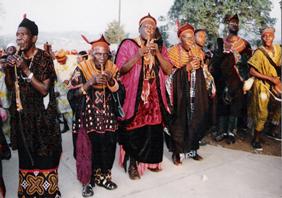Lela is an annual festival to commemorate the wars that the Chamba people in general and the Bali Nyonga in particular fought and the conquering of other tribes through their migratory path. Lela is a royal institution with the Fon as its head and the Lela institution is in charge of the Lela shrine called “Wolela”. When a Fon is inaugurated, he is presented to Bali Nyonga population by mounting the Wolela in a public ceremony.
The Lela festival is a four days public event and usually takes place in the Month of December. t starts with a launching ceremony called “Pob Lela” not open to public and a few days after the Lela festival begins.

Day 1 : “Suh’Fuh”
The first day is more of a religious day. It starts in early morning when the tradition flags “Tutuwans” are brought out of palace and placed in the Lela piazza. At about 1 p.m. the population gathered at the Lela piazza to start the male dominant two miles procession lead by the tutuwan to the sacred stream (shrine) called “nchi shuh fuh”. At the sacred stream, the two tutuwans (white flags) are purified and the gods of land appeased and asked to be on their side in case of any war. On their way back to the Lela piazza, they chant war songs to signify that they are prepared and ready for any war or attack. There is a brief stop at Kah Manfon’s residence for refreshment. When the population arrived at the Lela piazza, there is heavy gun firing followed by dancing till about 6:30 p.m.
Day 2 : “Lo’ti”
The second day is a day to commemorate the victories the Chamba and Bali Nyonga had on the wars they along their migratory path. The day is full of military manoeuvres and warlike exhibitions. The day starts with a silent procession to the hill side behind the ntanko’o market. The Fon during the silent procession is lead by men wearing caps made with bird feathers. The procession is silent as it signifies the movement of troops to the warfront and the men wear caps made of birds to deceive their enemies that it is a flock of bird moving and not humans. On arrival at ntanko’o (the supposed warfront), there is heavy gun firing for about 30 minutes. On the way back to the Lela piazza, there is a lot of military by the military wing, gun firing and singing of victorious songs. Same as day 1, when the population arrived at the Lela piazza, there is heavy gun firing followed by dancing till about 6:30 p.m.
Day 3 : “Ben”
As the name implies, (“Ben” is dance) the third day of the Lela festival mainly dancing and jubilations to signify that they are victors. There is no gun firing this day. The third day is more of political day as it on this day that the Fon appoints new nkoms (ministers) and gives an address about the state of the union. The day starts at about 2 p.m. with dancing with the men and women dressed in the best of their tradition regalia. At about 4 p.m. , dancing is halted and the Fon made known his newly appointees and delivers his state of the union through the nkoms and after that there is dancing till about 6:30 p.m.
Day 4 : “Kong Choh”
The fourth and last day of the Lela festival is mostly dancing with less gun firing. As the name “nchu nun kong” in mungaka implies, this is day that the two traditional flags “tutuwans” are taken back to where are kept inside the palace. The day begins at about 2 p.m. with dancing and at about 4 p.m. the Fon delivers an address about the future of the union. After the Fon’s address, the tutuwans (traditional flag) are taken into the palace followed by less gun firing. The day ends with the population bidding farewell to Lela and chanting “Lela bati lumo’ ka! Yo, yo” meaning Lela we only get see next year.

